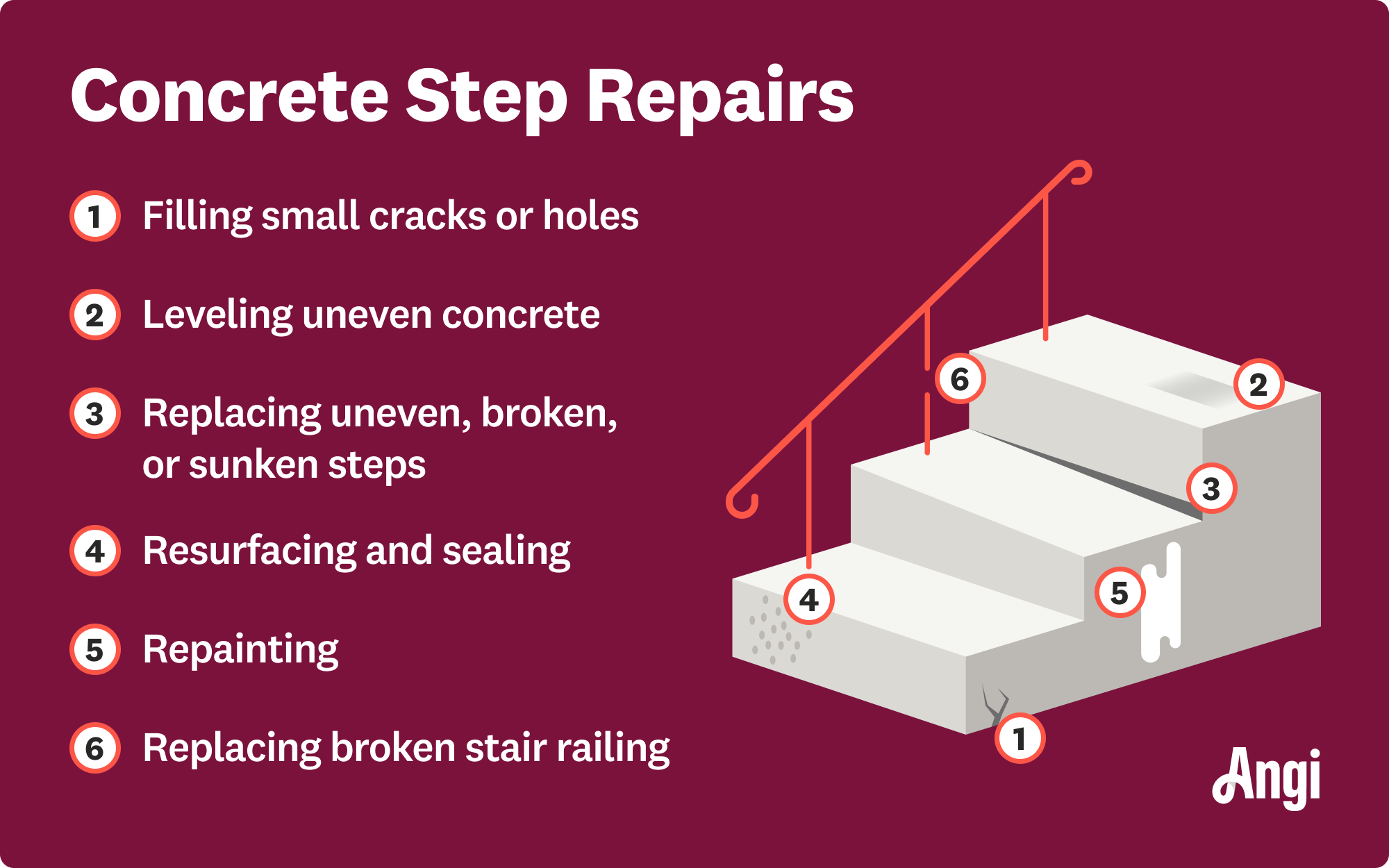
Discover how much concrete walls cost based on factors like their size, material, location, design, and local labor rates.
Step up your DIY skills by refreshing the look of your concrete stairs


Working with concrete can be intimidating, but repairing cracked or crumbling concrete steps is a pretty DIY-friendly home improvement project that can breathe new life into your home’s exterior appearance. Whether you’re fixing a potential trip hazard or just resurfacing the concrete to fix an eyesore, this guide will give you the tips and tools to learn how to repair concrete steps.

Before repairing concrete, sweep the steps to remove any dirt, rocks, and debris. Then, hit the area with a stiff spray from the garden hose.
For stained or heavily soiled steps, scrub them with a stiff-bristled brush and some liquid laundry detergent. You can also bring in a local power washer or rent equipment at your local hardware store for around $50 per day.
Either way, approach this task with caution: Too much pressure can further damage the steps, especially if the concrete is already weak and crumbling. Aggressive cleaning on damaged concrete can cause more issues that will require more work to fix.

Use either a wire brush or a hammer and chisel to knock off any loose bits of concrete from the damaged areas. Avoid using the wire brush to scrub away surface dirt and stains, as it can scratch the concrete.
If your concrete appears to be heavily damaged or weak, you might need help from a professional or possibly even a total step replacement. If you start chipping away loose concrete and find that even more pieces start crumbling off, we suggest pausing and calling a pro.

Mix up a batch of concrete according to the manufacturer’s instructions. Stir thoroughly to get rid of any lumps. We recommend using a quick-setting concrete since the repair won’t be structural in nature. Quick-setting concrete cures much more quickly, so your steps will be usable sooner. The consistency affects the flow rate of the concrete but also how it bonds to the existing steps and how quickly it cures.
“Be extra careful in the mixing phase,” says Matt DiBara, Expert Review Board member and owner of DiBara Masonry. “For flat repairs, you typically want the consistency of thick pancake batter; for corners, add a little less water, so it forms more of a putty.”

If you’re repairing corners, create a makeshift form to hold the concrete’s shape as it dries.
Screw or duct-tape two wooden boards together to make an L-shaped form. Make sure they create a 90-degree angle.
Spray the form with cooking spray to prevent it from sticking to the concrete. Alternatively, you can use two pieces of melamine to create the form. Concrete will not stick to the smooth surface of these boards. If you’re repairing concrete steps leading to a porch, we recommend you cover the porch with a contractor bag to prevent any concrete from dripping on it. If it does drip, spray the wet concrete off with a hose before it dries.
Lay the L-form flush with the top of the step.
Duct-tape the L-form firmly in place or use clamps, if possible, to prevent the concrete form from shifting as you work.

Using a paintbrush, apply a thick coat of concrete bonding agent to the areas you’ll be repairing. Before you apply the concrete, ensure the bonding agent is not puddling or dripping. For best results, you want it absorbed into the concrete but still damp to the touch.

Grab your trowel and scoop out some of the new concrete you mixed onto the areas where you applied the bonding agent. If you’re fixing step corners, press the concrete firmly into your wooden form.

Next, use the flat side of your trowel to smooth the concrete until it is flush with the stair’s surface. Use firm pressure to fill in any holes.

While the concrete is still wet, brush the surface with a concrete finishing brush or a masonry brush if your existing concrete steps are textured. This is a particularly important step if you’re repairing a large area on the surface, as smooth concrete can become slippery when wet.

Concrete is strongest when it dries slowly, as the chemical curing process continues if there is moisture remaining in the concrete. To maintain a healthy level of moisture, it’s best to cover the repaired section of concrete with a contractor bag and tape down the edges to trap moisture inside. This is not a necessary step, but we do recommend it especially for corner repairs, which are more susceptible to future damage.

Allow the concrete to dry overnight or however long the instructions specify. Once it’s dry, you can remove the wooden form if you used one, and your concrete steps should be as good as new.
However, if you find your steps remain uneven, chipped, or sunken, this could be a safety issue. We recommend you call a concrete step repair specialist near you to have a professional repair done if problems persist or return quickly.
Fixing concrete steps is a quick and simple process in most cases, but it’s not always a viable option. There are a few things you can look for that usually indicate that a replacement is a better option.
Excessive crumbling: If you find that your steps are crumbling in multiple places or that new pieces continue to break off as you’re preparing your steps for repair, replace the steps entirely. This often indicates general weakness in the concrete, which means repairs will only be temporary solutions.
Large cracks or breaks: If you find that you need to repair concrete cracks more than 1/8-inch thick or particularly large breaks in your steps, we recommend having a pro come out to assess the steps, check for unsupportive soil or other structural issues, and carry out a complete replacement.
Sinking or unlevel concrete steps: If you find that a section of your concrete steps is cracking off from the rest and sinking, a total replacement will be necessary. This kind of issue is usually indicative of loose soil beneath the steps or improper soil compaction before construction. It’s better to fix the issue now than repair it and have to pay for a replacement down the road.
Your new concrete cracks: All concrete is susceptible to settling and minor cracking in the first year or so after it is poured. However, if you lay down new concrete for a step repair and find that a large crack (over 1/8 inch) forms within that time frame, consider a replacement to address the underlying structural issue.
Ultimately, the up-front cost to repair concrete steps is almost always lower than a full replacement, but we recommend considering the long-term cost of additional repairs and eventual replacement as well. If you know your steps are badly damaged, old, or will need replacement soon, going with a total replacement now may save money on intermittent repairs.
The steps we’ve outlined above are simple, and most homeowners should be able to carry them out without any major issues, even if they don’t have any DIY experience.
If you’re working with minor repairs, like small corner sections of concrete that have broken off or minor resurfacing work, you can give it a shot. You’ll need to make sure you get the concrete mixture right. However, more complicated jobs should be left to pros.
If you’re intimidated by mixing concrete, want to save time, or believe there might be larger issues at play—like sinking steps or structural issues—then we recommend calling in a professional to get the job done correctly the first time around.
"While many things can be "DIY," we seriously recommend hiring a professional for concrete work. The number of "small jobs" homeowners start and then ask us to come in and fix is very high. "
— Mitch Coluzzi, Head of Construction at SoldFast
From average costs to expert advice, get all the answers you need to get your job done.

Discover how much concrete walls cost based on factors like their size, material, location, design, and local labor rates.

If your sidewalk is in need of some TLC, this is your comprehensive look at sidewalk replacement cost, so you know what to expect.

Looking to spruce up your home’s exterior and add some value? Use this concrete walkway cost guide to estimate the price of installing new paths.

It’s important to know when concrete’s structural integrity is at risk. Learn more about the types of cracks in concrete so you know what to look out for.

Broken concrete steps can be a safety risk and reduce your home’s curb appeal. Get them back in good condition by hiring a concrete contractor to repair concrete steps.

Discover the average driveway resurfacing cost, key price factors, and tips to save money on your project. Get expert insights to plan your driveway resurfacing.